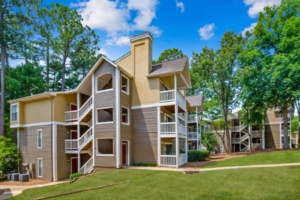
MULTIFAMILY UPDATE
A CCIM FEATURE ARTICLE

Increasing Interest
The multifamily sector continues to strengthen, with demand returning to gateway cities as newly popular destinations continue to attract renters.
By Sarah Hoban | Summer 2022
Investment in multifamily assets reached new highs in 2021. Colliers’ 2022 National Multifamily Report notes that multifamily sales volume reached $335.3 billion — more than office and industrial sales combined. With increased demand and higher rents, the sector continues to look strong midway through this year. But like all other industries, it’s also facing challenges as well, including inflation, higher interest rates, higher construction costs, and supply chain issues.
“We’re seeing higher interest rates, and that, of course, increases the cost of capital for apartment investors,” says Christopher Bruen, senior director of research for the National Multifamily Housing Council. “Up until the first quarter of the year, that’s been more than offset by higher rent growth, with cap rates remaining at record lows. But while rent growth has more than compensated for inflation over the last two years, the question remains whether that can continue going forward if we come up against affordability constraints.”
Perhaps the biggest challenge has been an increase in demand. Apartment List’s May National Rent Report noted a national vacancy index of 4.6 percent — up from a low of 3.8 percent in August 2021 but still considerably lower than the 7.1 percent figure in April 2020, at the start of the pandemic.
And while 1Q2022 multifamily construction starts increased by 501,000 units — an increase of 37.3 percent over February 2021 — the number of completed units declined 16.9 percent to 266,000 units, according to the National Apartment Association’s Spring 2022 Apartment Market Pulse. NAA also pointed out that apartment construction could be sluggish for the rest of 2022 because of labor market challenges and rising energy prices.
Construction costs continue to play a major role. The National Multifamily Housing Council conducts a quarterly survey of construction and development activity and, says Bruen, respondents have reported a 45 percent increase in lumber costs over the first part of 2022. “That’s the most extreme,” Bruen says, “but other materials have been affected, too — electronic components, finishes, and roofing. This is making construction more difficult — all at a time where we have a housing shortage and vacancies at all-time lows.”
“The intensity of the supply chain issues that we saw in the midst of the pandemic are, hopefully, beginning to even out,” says Candice Chevaillier, CCIM, principal at Lee & Associates in Seattle, “but I think we have a ways to go.” Items produced overseas, for example, “are still going to be at mercy of additional waves of COVID-19 — many governments are serious about [quarantine] restrictions.”
Rent Growth Ahead
Increased costs and demand have made their mark on rents. Apartment List reported a national year-over-year rent growth of 16.3 percent from April 2021. For comparison, the site reported a 3.3 percent increase in 2018, a 2.3 percent increase in 2019, and a 1.6 percent decline in 2020. Yardi Matrix figures put overall March rents at $1,642, $212 higher than March 2021.
Rents have increased fastest in Sunbelt areas. A study by three universities looked at the most overvalued U.S. rental markets, with the top five all in Florida. The research — produced by Florida Atlantic University Real Estate Initiative and Florida Gulf Coast University’s Lucas Institute for Real Estate Development and Finance — examined historical data that show where rents should be and compared that with current marketplace rents. Miami-Fort Lauderdale is the most overvalued, with an average rental price of $2,832, 21.75 percent higher than the area’s long-term leasing trends.
Chevaillier points to another factor for dramatic rent increases. During the pandemic, she says, “a lot of buildings in our region were under eviction moratoriums, and rent increases were banned. For two years, costs continued to increase, but there was no way to increase income as well. Now that we’ve come out of that, rents are moving quite quickly.”
Rental demand has also been squeezed by the single-family housing market, which faces supply shortages of its own. A market report from real estate brokerage firm HouseCanary noted that the net new listings for U.S. single-family homes dropped 12 percent from April 2021 to April 2022.
Higher interest rates and inflation also deter renters looking to make the move toward home ownership. As of May, mortgage rates rose to 5.1 percent, up 2 full percentage points from January’s 3.1 percent. “What we’re seeing is that the higher interest rates may bring home values down in the short-term because people can’t pay as much,” says Chevaillier. “But realistically, it makes the debt service on those homes more expensive, which puts them out of reach and locks renters into renting, not buying.” And, she adds, inflation in general makes saving difficult for renters because the increased cost of living can whittle away savings for a down payment.
Among those hardest hit by home ownership affordability are millennial buyers. Recent statistics from Apartment List show that in 2021, nearly two-thirds of those surveyed reported that they had no savings, and only 16 percent had saved more the $10,000. (“The average savings of just over $12,000 represents a 4 percent down payment on a median-priced condo today,” Apartment List noted.) Post-pandemic, 24.7 percent of millennials surveyed said that they never expected to buy a home and would rent permanently.
Markets to Watch
So given the challenges, what opportunities are available to multifamily CRE professionals? A closer look at burgeoning markets, for starters. While growth remains strong in Sunbelt areas, Marcus & Millichap’s April multifamily research brief countered that gateway markets such as New York, Boston, Chicago, and Los Angeles were picking up strength as well. “After encountering a disproportionate number of hurdles in 2020 and early 2021, apartment demand has soared in the nation’s gateway metros,” the report notes, and these markets were in strong competition with Sunbelt metros such as Dallas-Fort Worth, Houston, and Phoenix for the country’s largest increases in occupied units.
The report cited several reasons, including an increase in job creation as well as new household formation in these areas. The leaders in the report’s survey of post-pandemic rent increases remained Sunbelt stalwarts Tampa-St. Petersburg, Phoenix, Atlanta, Dallas-Fort Worth, and Orange County, Calif. However, the report noted that there was still room for rent growth in gateway markets, as their rents hadn’t increased as significantly as other markets with large population influxes. “Furthermore,” the report adds, “none of the gateway metros have vacancy issues or outsized construction activity that could derail returning momentum for rent growth results.”
And in fact, says NMHC’s Bruen, during the pandemic, “there was a shift in demand away from smaller units — one-bedrooms and studios — in the most expensive coastal markets and a shift toward affordable markets, especially in the Sunbelt. In 2021, we started to see those coastal markets recover, and at this point it’s beyond recovery — really, everywhere it’s strong.”
Demographics play a role in determining a market’s appeal as well. StorageCafe, an online storage space marketplace, surveyed more than 3 million renters’ applications in 257 markets to determine patterns of net renter migration (a city’s inbound minus outbound residents). The study found that the Dallas suburbs attracted the most out-of-state applicants. These cities, dubbed “feeder cities,” include Irving and Lewisville, and offer good space for affordable prices, employment opportunity, and proximity to Dallas attractions.
While other top markets included other Sunbelt locales, a few surprises included the Great Plains states. “Traditionally losing ground to more hyped states on the East and West coasts,” the study noted, “U.S. prairie states, such as North Dakota, South Dakota, and Nebraska, have been intent on amping up their appeal in recent times. The Dakotas both saw double the number of incoming renters than outgoers, with Maine the only other state registering the same high figure.” The study adds that Sioux Falls, S.D., in fact, offered the country’s highest ratio of inbound-versus-outbound residents at almost four to one.
Post-pandemic, many younger renters are striking out on their own and, according to Rent Cafe, activity among Gen Z renters has increased by 21 percent this year, the largest boost among any age group. These renters are targeting large urban areas that provide employment, diversity, and cultural and social activities, with top trending cities including San Francisco, New York, Philadelphia, Boston, and Arlington, Va. One up-and-coming hot spot: Jersey City, N.J., which features new construction and proximity to Manhattan with relatively affordable prices.
Quality of life is also an essential consideration for a market’s appeal. Chevaillier notes that in Seattle she’s observed the popularity of mixed-use neighborhood developments with multifamily buildings, along with retail, entertainment, outdoor space, and parks. “Those micromarkets can be very strong and in high demand. They’re very attractive to tenants.”
Higher interest rates and inflation also deter renters looking to make the move toward home ownership. As of May, mortgage rates rose to 5.1 percent, up 2 full percentage points from January’s 3.1 percent.
Location can also determine which multifamily sectors have the strongest rent growth. According to recent CBRE statistics, rents for Class C multifamily properties have outpaced Class A and B properties nationally, although the balance is tipped because of larger coastal markets such as L.A., Washington, D.C., and Boston, where, says CBRE, renters compete for a limited supply of value-add Class C units. In Sunbelt areas, on the other hand, Class A and B rents are growing more quickly.
Sustainability and Livability
Multifamily developers and owners are also increasingly needing to factor in costs for sustainability features in new construction. A recent Cushman & Wakefield study found that LEED-certified multifamily properties consistently command higher rents than comparable noncertified properties — about 3 percent higher as of 4Q2021. While the study showed that such properties often have lower occupancies, the rent premium more than compensated.
Sustainable features may involve higher upfront costs for developers, but they can save money in the long run, says Caitlin Sugrue Walter, NMHC’s vice president for research. “It varies by situation. Our recent resident-preferences survey that showed there are a lot of technology features that residents find value in and expect to have.” But, she adds, these features have also come up against supply chain delays. “[Computer] chips for example, are still a big problem. We’re hopeful it will get better, but if you have key fob entry, obviously that’s a problem both for new construction and operations. You either have to pay more or come up with some other solution.”
The benefits of sustainable technologies can become a challenge when they’re mandated through municipalities’ energy efficiency standards, says Chevallier. That can drive up construction costs and affect affordable housing. “Our developer clients prefer carrots over sticks,” she says. “Offer up these technologies, let us adopt them, and let the market dictate.”
One other post-pandemic fallout for multifamily: Work from home. During COVID-19 lockdowns, home-based workers sought out larger alternatives to studios and small one-bedroom apartments. Such units were affordable as they were farther from central business districts, but since renters didn’t need to commute, they were appealing. “That was definitely one of the drivers behind that shift toward larger units and more affordable markets,” says NMHC’s Bruen. “But as the market has recovered, it’s unclear where that’s going to have longer-term implications.”
One other post-pandemic fallout for multifamily: Work from home. During COVID-19 lockdowns, home-based workers sought out larger alternatives to studios and small one-bedroom apartments.
In Seattle, says Chevaillier, “before the pandemic we had committed to building a lot of smaller efficiency or studio units. During the pandemic, we saw that when tenants were faced with being locked down in their 300-sf efficiency units, the walls got pretty small. So, we saw demand for one-bedrooms plus den, or two- and three-bedrooms. Now we’re starting to see that swing the other way again. But the reality is that tenants are going to be working from home in some capacity more than they were before, so thoughts around space planning have to reflect that. Maybe there’s coworking space within buildings or some other type of third place.”
She adds that those in the multifamily space will need to put more importance on creating a sense of place for renters. “Where people want to live and work has a lot to do with where they have the ability to socialize and enjoy recreational amenities,” she says. “The more that apartment projects can be thoughtful of that full picture, we’ll be much more successful, as workers get back to work and want to be in locations that have those kinds of amenities. Those assets will be more successful than those who put their stake out in the middle of nowhere and expect people to drive there. That’s what’s really changed.”
Sarah Hoban
Sarah Hoban is a business writer based in Chicago.
***********************************************************************************************************************************
Small Businesses Fall Behind on Hiring – Inflation Takes a Toll
Jim Gahlsdorf, owner of Gahlsdorf Logging, at a work site in Lincoln County, Ore.
PHOTO: CELESTE NOCHE FOR THE WALL STREET JOURNAL
Companies with under 50 workers lost head count in three of the past four months, data show, reflecting difficulties in keeping pace on wages and benefits
Small businesses are losing ground in the hiring game.
Head counts at companies with fewer than 50 employees declined in three of the past four months, according to ADP payroll data, even as employment at larger firms continued to grow.
Owners of many small companies say inflation has added to the pressures of an already tight job market, making it increasingly difficult to keep pace with the wages and benefits offered by large employers. The hiring challenges are stunting growth, small-business owners say, and further clouding their deteriorating economic outlook.
At Gahlsdorf Logging Inc., the head count is stuck at around 20, making it difficult for the Rickreall, Ore., logging contractor to keep its eight-person crews fully staffed. Owner Jim Gahlsdorf said he turns down an offer about once a month to look at or bid on a potential job because he doesn’t have the workers.
Some small logging operators have dropped to one crew from two in response to labor shortages. Mr. Gahlsdorf said he worries that a slimmed-down operation wouldn’t produce enough revenue to cover overhead. He is hoping that as the number of crews operated by competitors declines, customers will pay more for his services, allowing him to pay his workers more.
“If we keep retreating from this problem, we will never solve it, and that will be the end of my business,” Mr. Gahlsdorf said. “If we just hang on, we will be in a better spot.”
Sixty-three percent of small-business owners say that hiring challenges are affecting their ability to operate at full capacity, according to a June survey of more than 825 small businesses for The Wall Street Journal by Vistage Worldwide Inc., a business coaching and peer advisory firm.
Some large companies that saw significant growth during the Covid-19 pandemic are beginning to take a more cautious approach to hiring, which could over time create more opportunities for smaller employers to bolster their ranks. For now, however, “small firms are still playing catch up,” ADP chief economist Nela Richardson said. If the economy weakens, small firms are also likely to change their hiring plans, she added.
Small-business confidence continues to fall, dropping in June to lows last seen in July 2020, the Vistage data show. Nine percent of small-business owners expect U.S. economic conditions to improve over the next 12 months, down from 12% in May and 53% in June 2021. Despite their economic worries, 52% of small-business owners expect head counts to increase in the coming year, the survey found.
Like companies of all sizes, small businesses are spending more to attract and retain workers. Seventy-six percent of small-business owners said they had boosted wages in response to labor-market challenges, according to the Vistage survey, while 44% reported adding employee benefits.
Mr. Gahlsdorf’s logging company has raised starting pay by about $5 in the past year. A recent Facebook ad offered starting pay of $25 to $26 an hour for “choker setters,” who fasten steel cables around logs. “[W]e will train the right person!” the ad said. “No drugs. Show up. Learn. Work Hard. Get Logs. Make $$.”
Black Earth Compost, an organic-waste collection and compost-processing company in Manchester, Mass., with 78 employees, starts drivers at $18 an hour. Last year, the company began offering a $3-per-hour bonus to drivers who start on time, make all their pickups and deliveries and meet other performance targets.
“That stopped the hemorrhaging, but it’s been tight ever since,” said owner Conor Miller, who recently brought in someone to help with hiring and has increased company benefits. The company added a 401(k) retirement savings plan last year and now allows employees to receive a portion of their pay in the form of bitcoin, which until the recent volatility in the cryptocurrency market was a big draw for younger workers.
Small-business owners often pitch in themselves when staffing shortages arise. At Goulding & Wood Pipe Organ Builders, which builds and maintains pipe organs, the employee responsible for installing control systems and wiring consoles quit in November after four years on the job. The Indianapolis-based company, which employs 13 people, still hasn’t found a replacement.
“I’ve pretty much taken over most of the responsibilities,” said owner Mark Goulding, who has raised wages twice since the fourth quarter of last year. “It’s why I am in Grand Rapids, Mich., today, finishing a job he should have done.”
The growth of remote work has made it easier for large employers to poach workers in faraway locations where the pay scales may be lower. Health Designs, a workplace wellness company, based in Ponte Vedra Beach, Fla., recently lost an executive to a company based in Boston and another employee to a Canadian company, both offering remote work and higher pay.
“We are no longer competing with other local companies in local geographies. We are competing against the world,” said Health Designs Chief Executive Chris Margolin, who recently filled one position but still has two openings in his 18-person home office.
Staffing gaps can take a toll on customer service. Freeway Towing Inc., in Monterey Park, Calif., has 46 employees, down from nearly 70 before the pandemic. The company, which provides towing, repairs and accident clean up, would employ 100 or more people if finding workers wasn’t such a challenge, said co-owner Nadia Haddad.
It now takes up to three hours for one of the company’s 67 trucks to arrive at an accident scene or pick up a stranded motorist, up from a more typical 20 or 30 minutes when the company is fully staffed, Ms. Haddad said. Angry motorists also call more to complain, which has led to more turnover among the office staff.
“The average office staff person in my company would stay for 10 to 12 years,” said Ms. Haddad. “Since the pandemic, I’m lucky if I keep them for two years.”
The company has boosted hourly wages and productivity bonuses and now pays for employees to be certified as Class A drivers, allowing them to operate wreckers, cranes and other heavy-duty vehicles. But it can’t match larger companies when it comes to paid time off and other benefits, she said.
“The pay is good. The hours are flexible. What we do for a living is rewarding,” said Ms. Haddad. “It’s just that the competition is magnificent. It’s significantly more magnificent than me.”
*******************************************************************************************************
Soaring Rents Make It a Very Good Time to Own an Apartment Building
The 10% rise in national asking rents in August is highest on record, helped by more young workers returning to cities

Apartment occupancy rates hit a record high of 97.1% in August.
PHOTO: SKYSITEIMAGES
Article by: Will Parker for The Wall Street Journal
Despite a yearlong national eviction ban and continuing pandemic, it has rarely been a better time to be a big apartment-building landlord.
National asking rents rose 10.3% in August, measured on an annual basis, according to Real Page, a rental-management software company, which analyzed more than 13 million professionally managed apartments. That marked the first double-digit increase in the more than 20 years this data has been collected, and in several hot cities the rent increases were much greater than the national figure.
“The rent growth that we’re seeing in places like Phoenix and Las Vegas and Tampa, it’s obviously unprecedented,” said Jay Parsons, deputy chief economist for Real Page. August rents rose more than 20% year over year in each of these cities. Monthly rents were up more than 20% in smaller markets like Boise, Idaho, and Naples, Fla., too.
Fast-rising rents reflect several factors, analysts say. Younger adults who lived with family last year are now renting their own apartments, in many cases as they prepare to head back to the office. Middle-income workers who have been priced out of the scorching housing market have little choice but to pay higher rents. Limited growth in new apartment supply, meanwhile, can’t keep up with demand.
Apartment occupancy rates, a key metric for helping landlords determine how much they can increase rent, hit a record high of 97.1% in August. Household incomes for new renters at professionally managed properties also reached a new high of more than $70,000 a year, according to Real Page. An end to the federal eviction ban last month is likely to further strengthen landlords’ hands.
Multifamily-property values have increased 13% since before the pandemic, according to real-estate securities advisory Green Street. More money is being invested now in apartment buildings than in any other type of commercial real estate, according to data company Real Capital Analytics.
Few analysts predicted this scenario 18 months ago. When Covid-19 hit, the U.S. unemployment rate rose to nearly 15%. Surveys showed an increasing number of renters falling behind on their payments, and federal and local eviction bans often meant these tenants couldn’t be replaced. Uncertainty about rent collections sent chills through the debt markets, raising concerns about a liquidity crunch in multifamily real estate.
Now, most segments of the multifamily market look strong. Even as more renters migrate back to cities, suburban markets continue to sizzle as record-high home-sale prices keep more people in rental housing. Others are relocating and working from home.
“Multifamily is able to capitalize on both of those trends,” said Karlin Conklin, principal of Investors Management Group, which has buildings in the suburban areas of cities like Raleigh, N.C., and San Antonio.

Multifamily-property values have increased 13% since before the pandemic, according to real-estate securities advisory Green Street
The rent increases mean that tenants who enjoyed big discounts last year are in for a rude awakening. In Nashville, Tenn., 27-year-old business analyst Zachary Wendland rented a one-bedroom apartment in a luxury rental high-rise for $1,420 a month in October. In June, the building was sold to Camden Property Trust, a publicly traded landlord, in one of the priciest-ever multifamily sales in the city.
Mr. Wendland wasn’t given the option to renew his lease with the new owner, but a similar unit in the building is now on the market for $2,199. “I couldn’t imagine a year ago paying $2,000 to live here,” he said. Now, he is apartment hunting again.
Some individual investors have felt excluded from the rent rally. These landlords own about 41% of all rental properties nationwide, including the majority of single-family rentals, according to U.S. Census Bureau surveys. Unemployment for lower-income workers caused many renters to miss payments, and eviction bans usually meant landlords had limited recourse. These building owners don’t have the scale to absorb unpaid-rent problems as easily as a corporate owner with thousands of apartment units.
A recent survey of about 1,000 small rental owners from the National Rental Home Council, a landlord trade group for single-family rental-home owners, found that one-third had sold or planned to sell a rental home because of the effects of the eviction moratorium on their business, with most selling to owner-occupiers.
Still, if unpaid rent is pushing more rental-home landlords to exit the business, it couldn’t come at a better time. National home-sale prices are up 18% over the past year.
Mortgage lending to multifamily owners has returned to pre-pandemic levels. Many landlords have tapped ultralow interest rates to refinance their mortgages, increasing their cash on hand and lowering their mortgage payments, said Jamie Woodwell, vice president of research and economics at Mortgage Bankers Association, a real-estate-lending industry group. Much of the pandemic lending was driven by the government-backed mortgage programs, he said. But other lenders have since ramped up their multifamily business.
“You don’t have a single private source of capital that isn’t interested in lending on multifamily,” said Willy Walker, chairman and chief executive of commercial real-estate firm Walker & Dunlop Inc.
Where landlords have problems with their loans, the federal government has stepped in to help. The Department of Housing and Urban Development, and the government-backed mortgage giants Fannie Mae and Freddie Mac, crafted forbearance programs for covered building owners who saw drops in their rent collections. The Federal Reserve Bank also stepped in to purchase more than $10.5 billion in multifamily mortgage-backed securities since last spring, which helped encourage more lending.
The $46 billion in emergency rental assistance provided by Congress—and in most cases paid directly to landlords—is also slowly starting to help more building owners with unpaid rent. “That assistance has been extraordinary,” said Ms. Conklin. Her company has earned back 25% of its unpaid rent and expects more in the coming months, she said.
For most real-estate companies, going under because of unpaid rent is “unlikely,” Mr. Walker said. “There are not many operators who have such a high level of nonpayment that it is going to cause them to default on their loan,” he said.
This article appeared in the October 14, 2021, print edition of The Wall Street Journal as ‘Soaring Rents Make It a Very Good Time to Own an Apartment Building’ by Will Parker.
